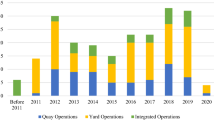Abstract
How quay cranes (QC) are scheduled is vital to the productivity of seaside container port operations. Double cycling concept is an operation strategy of loading the containers into ships as they are unloaded, thus improving the efficiency of a QC as well as the container port. Goodchild and Daganzo (Transp Sci 40(4):473–483, 2006) first described QC double cycling problem and solved the problem after formulating it into a two machine flow shop problem. Song (Port Technol Int 36:50–52, 2007) studied the formula to determine the optimal starting sequence for double cycling while reflecting on the practical issue of QC working direction. The above studies focused on a single QC double cycling and their empirical trials showed the double cycling could improve the productivity of each QC approximately by between 10 and 20 %. In Zhang and Kim (Comput Ind Eng 56(3):979–992, 2009), a multiple QC double cycling model was first suggested by formulating a mixed integer programming model to maximise the number of double cycles between multiple QCs. In the present paper we point out a flaw with the existing multiple QC double cycling model that lets cycles that are not implementable. In addition, the paper discusses the need for imposing constraints arising from real world requirements to the formulations aiming at double cycling.








Similar content being viewed by others
Notes
Inside a ship, containers stacked in the vertical direction are linked together by twist-locks (or cones) on four corners. The four corners of a 40-foot unit on top of two 20-foot units can be adequately linked by twist-locks, but the opposite can fix only two corners of each 20-foot container on either side. This may cause containers to digress while the ship is sailing.
Loading can begin as soon as at least one stack has been unloaded or is empty. Loading can proceed in any unloaded or empty stack until loading operations are complete. If there is no column available, the loading operations must wait. This is called blocking delay (Goodchild and Daganzo 2004).
References
Avriel, M., Penn, M., Shpirer, N., & Witteboon, S. (1998). Stowage planning for container ships to reduce the number of shifts. Annals of Operations Research, 76, 55–71.
Bierwirth, C., & Meisel, F. (2009). A fast heuristic for quay crane scheduling with interference constraints. Journal of Scheduling, 12(4), 345–360.
Bierwirth, C., & Meisel, F. (2010). A survey of berth allocation and quay crane scheduling problems in container terminals. European Journal of Operational Research, 202(3), 615–627.
Feo, T., & Resende, M. (1995). Greedy randomized adaptive search procedures. Journal of Global Optimization, 6(2), 109–133.
Gadeyne, B., & Verhamme, P. (2011). Optimizing maritime container terminal operations. Master’s thesis, Ghent University, Belgium.
Glover, F. (1989). Tabu search-part i. ORSA Journal on Computing, 1(3), 190–206.
Goodchild, A. (2005). Crane double cycling in container ports: algorithms, evaluation, and planning. PhD thesis, University of California, Berkeley.
Goodchild, A., & Daganzo, C. (2004). Reducing ship turn-around time using double-cycling. Institute of Transportation Studies, University of California, Berkeley.
Goodchild, A., & Daganzo, C. (2006). Double-cycling strategies for container ships and their effect on ship loading and unloading operations. Transportation Science, 40(4), 473–483.
He, X., Wang, S., & Zheng, J. (2011). A hybrid heuristic algorithm for integrated large-capacity quay crane scheduling problem. In Computer Research and Development (ICCRD), 2011 3rd international conference on, IEEE, vol. 1, pp. 309–312.
Johnson, S. (1954). Optimal two-and three-stage production schedules with setup times included. Naval Research Logistics Quarterly, 1(1), 61–68.
Kim, K., & Park, Y. (2004). A crane scheduling method for port container terminals. European Journal of Operational Research, 156(3), 752–768.
Moccia, L., Cordeau, J., Gaudioso, M., & Laporte, G. (2006). A branch-and-cut algorithm for the quay crane scheduling problem in a container terminal. Naval Research Logistics (NRL), 53(1), 45–59.
Sammarra, M., Cordeau, J., Laporte, G., & Monaco, M. (2007). A tabu search heuristic for the quay crane scheduling problem. Journal of Scheduling, 10(4), 327–336.
Song, J. (2007). A study for optimization of double cycling in container ports. Port Technology International, 36, 50–52.
Wang, D., Li, X., & Wang, Q. (2011). A two-stage composite heuristic for dual cycling quay crane scheduling problem. In Systems, Man, and Cybernetics (SMC), 2011 IEEE international conference on, IEEE, pp. 1902–1907.
Zhang, H., & Kim, K. (2009). Maximizing the number of dual-cycle operations of quay cranes in container terminals. Computers & Industrial Engineering, 56(3), 979–992.
Acknowledgments
The authors would like to thank the referees for their valuable comments and suggestions.
Author information
Authors and Affiliations
Corresponding author
Rights and permissions
About this article
Cite this article
Ku, D., Arthanari, T.S. On double cycling for container port productivity improvement. Ann Oper Res 243, 55–70 (2016). https://doi.org/10.1007/s10479-014-1645-z
Published:
Issue Date:
DOI: https://doi.org/10.1007/s10479-014-1645-z




